cypress公司的FM0-64L-S6E1C3系列是高讀集成的32位MCU,設(shè)計(jì)用于低功耗和低成本的嵌入式控制器.器件具有集成了片上閃存和SRAM的ARMCortex-M0+處理器,還包含了各種定時(shí)器,ADC和各種通信接口(UART,CSIO(SPI),I2C,I2S,智能卡和USB)等在內(nèi)的外設(shè)功能.工作頻率高達(dá)40.8MHz.本文介紹了FM0-64L-S6E1C3系列產(chǎn)品主要特性,框圖,以及FM0-64L-S6E1C3 MCU入門開發(fā)板主要特性和元件分布圖,系統(tǒng)框圖,電路圖,材料清單和PCB設(shè)計(jì)文件.
The S6E1C3 Series is a series of highly integrated 32-bit microcontrollers designed for embedded controllers aiming at low powerconsumption and low cost. This series has the ARM Cortex-M0+ Processor with on-chip Flash memory and SRAM, and consists ofperipheral functions such as various timers, ADC and communication interfaces (UART, CSIO (SPI), I2C, I2S, Smart Card, and USB).
The products which are described in this data sheet are placed into TYPE3-M0+ product categories in "FM0+ Family PeripheralManual".
FM0-64L-S6E1C3主要特性:
32-bit ARM Cortex-M0+ Core
? Processor version: r0p1
? Maximum operating frequency: 40.8 MHz
? Nested Vectored Interrupt Controller (NVIC): 1 NMI(non-maskable interrupt) and 24 peripheral interrupt with 4selectable interrupt priority levels
? 24-bit System timer (Sys Tick): System timer for OS taskmanagement
Bit Band Operation
Compatible with Cortex-M3 bit band operation.
On-Chip Memory
? Flash memory
? Up to 128 Kbytes
? Read cycle: 0 wait-cycle
? Security function for code protection
? SRAM
The on-chip SRAM of this series has one independent SRAM .
? Up to 16 Kbytes
? 4Kbytes: can retain value in Deep standby Mode
USB Interface
USB interface is composed of Device and Host
With Main PLL, USB clock can be generated by multiplicationof Main clock.
? USB Device
? USB 2.0 Full-Speed supported
? Max 6 EndPoint supported
? EndPoint 0 is control transfer
? EndPoint 1, 2 can be selected Bulk-transfer,Interrupt-transfer or Isochronous-transfer
? EndPoint 3 to 5 can select Bulk-transfer orInterrupt-transfer
? EndPoint 1 to 5 comprise Double Buffer
? The size of each EndPoint is according to the follows
? EndPoint 0, 2 to 5 : 64 bytes
? EndPoint1 : 256 bytes
? USB host
? USB 2.0 Full/Low-Speed supported
? Bulk-transfer, Interrupt-transfer and Isochronous-transfersupport
? USB Device connected/disconnected automatically detect
? IN/OUT token handshake packet automatically
? Max 256-byte packet-length supported
? Wake-up function supported
Multi-Function Serial Interface (Max 6channels)
? 3 channels with 64Byte FIFO (Ch.4, 6 and 7), 3 channelswithout FIFO (Ch.0, 1 and 3)
? The operation mode of each channel can be selected fromone of the following.
? UART
? CSIO (CSIO is known to many customers as SPI)
? I2C
? UART
? Full duplex double buffer
? Parity can be enabled or disabled.
? Built-in dedicated baud rate generator
? External clock available as a serial clock
? Hardware Flow control* : Automatically control thetransmission by CTS/RTS (only ch.4)
* : S6E1C32B0A/S6E1C31B0A andS6E1C32C0A/S6E1C31C0A do not support HardwareFlow control.
? Various error detection functions (parity errors, framingerrors, and overrun errors)
? CSIO (also known as SPI)
? Full duplex double buffer
? Built-in dedicated baud rate generator
? Overrun error detection function
? Serial chip select function (ch1 and ch6 only)
? Data length: 5 to 16 bits
? I2C
? Standard-mode (Max: 100 kbps) supported / Fast-mode(Max 400 kbps) supported.
? I2S (MFS-I2S)
? Using CSIO (Max 2 ch: ch.4, ch.6) and I2S clock generator
? Supports two transfer protocol
? I2S
? MSB-justified
? Master mode only
I2C Slave
? I2C Slave supports the slave function of I2C and wake-upfunction from Standby mode.
Descriptor System Data Transfer Controller (DSTC)(64 Channels)
? The DSTC can transfer data at high-speed without going viathe CPU. The DSTC adopts the Descriptor system and,following the specified contents of the Descriptor that hasalready been constructed on the memory, can access directlythe memory / peripheral device and performs the datatransfer operation.
? It supports the software activation, the hardware activation,and the chain activation functions
A/D Converter (Max: 8 Channels)
? 12-bit A/D Converter
? Successive approximation type
? Conversion time: 2.0 μs @ 2.7 V to 3.6 V
? Priority conversion available (2 levels of priority)
? scan conversion mode
? Built-in FIFO for conversion data storage (for scanconversion: 16 steps, for priority conversion: 4 steps)
Base Timer (Max: 8 Channels)
The operation mode of each channel can be selected from oneof the following.
? 16-bit PWM timer
? 16-bit PPG timer
? 16/32-bit reload timer
? 16/32-bit PWC timer
General-Purpose I/O Port
This series can use its pin as a general-purpose I/O port whenit is not used for an external bus or a peripheral function. Allports can be set to fast general-purpose I/O ports or slowgeneral-purpose I/O ports. In addition, this series has a portrelocate function that can set to which I/O port a peripheralfunction can be allocated.
? All ports are Fast GPIO which can be accessed by 1cycle
? Capable of controlling the pull-up of each pin
? Capable of reading pin level directly
? Port relocate function
? Up to 54 fast general-purpose I/O ports @64-pin package
? Certain ports are 5 V tolerant.
Dual Timer (32-/16-bit Down Counter)
The Dual Timer consists of two programmable 32-/16-bit downcounters. The operation mode of each timer channel can beselected from one of the following.
? Free-running mode
? Periodic mode (= Reload mode)
? One-shot mode
Real-Time Clock
The Real-time Clock countsyear/month/day/hour/minute/second/day of the week from year00 to year 99.
? The RTC can generate an interrupt at a specific time(year/month/day/hour/minute/second/day of the week) andcan also generate an interrupt in a specific year, in a specificmonth, on a specific day, at a specific hour or at a specific
minute.
? It has a timer interrupt function generating an interrupt upona specific time or at specific intervals.
? It can keep counting while rewriting the time.
? It can count leap years automatically.
Watch Counter
The Watch Counter wakes up the microcontroller from the lowpower consumption mode. The clock source can be selectedfrom the main clock, the sub clock, the built-in high-speed CRclock or the built-in low-speed CR clock.
Interval timer: up to 64 s (sub clock: 32.768 kHz)
External Interrupt Controller Unit
? Up to 12 external interrupt input pins
? Non-maskable interrupt (NMI) input pin: 1
Watchdog Timer (2 Channels)
The watchdog timer generates an interrupt or a reset when thecounter reaches a time-out value.This series consists of two different watchdogs, hardwarewatchdog and software watchdog.
The hardware watchdog timer is clocked by the built-inlow-speed CR oscillator. Therefore, the hardware watchdog isactive in any low-power consumption modes except RTC, Stop,
Deep standby RTC and Deep standby Stop mode.
CRC (Cyclic Redundancy Check) Accelerator
The CRC accelerator calculates the CRC which has a heavysoftware processing load, and achieves a reduction of theintegrity check processing load for reception data and storage.
? CCITT CRC16 and IEEE-802.3 CRC32 are supported.
? CCITT CRC16 Generator Polynomial: 0x1021
? IEEE-802.3 CRC32 Generator Polynomial: 0x04C11DB7
HDMI-CEC/Remote Control Receiver (Up to 2Channels)
? HDMI-CEC transmitter
? Header block automatic transmission by judging Signalfree
? Generating status interrupt by detecting Arbitration lost
? Generating START, EOM, ACK automatically to outputCEC transmission by setting 1 byte data
? Generating transmission status interrupt when transmitting1 block (1 byte data and EOM/ACK)
? HDMI-CEC receiver
? Automatic ACK reply function available
? Line error detection function available
? Remote control receiver
? 4 bytes reception buffer
? Repeat code detection function available
Smart Card Interface (Max 1 Channel)
? Compliant with ISO7816-3 specification
? Card Reader only/B class card only
? Available protocols
? Transmitter: 8E2, 8O2, 8N2
? Receiver: 8E1, 8O1, 8N2, 8N1, 9N1
? Inverse mode
? TX/RX FIFO integrated (RX: 16-bytes, TX:16-bytes)
Clock and Reset
? Clocks
A clock can be selected from five clock sources (two externaloscillators, two built-in CR oscillator, and main PLL).
? Main clock: 8 MHz to 48 MHz
? Sub clock: 32.768 kHz
? Built-in high-speed CR clock: 8 MHz
? Built-in low-speed CR clock: 100 kHz
? Main PLL clock 8MHz to 16MHz (Input),75MHz to 150MHz (Output)
? Resets
? Reset request from the INITX pin
? Power on reset
? Software reset
? Watchdog timer reset
? Low-voltage detection reset
? Clock supervisor reset
Clock Supervisor (CSV)
The Clock Supervisor monitors the failure of external clockswith a clock generated by a built-in CR oscillator.
? If an external clock failure (clock stop) is detected, a reset isasserted.
? If an external frequency anomaly is detected, an interrupt ora reset is asserted.
Low-Voltage Detector (LVD)
This series monitors the voltage on the VCC pin with a 2-stagemechanism. When the voltage falls below a designated voltage,the Low-voltage Detector generates an interrupt or a reset.
? LVD1: monitor VCC and error reporting via an interrupt
? LVD2: auto-reset operation
Low Power Consumption Mode
This series has six low power consumption modes.
? Sleep
? Timer
? RTC
? Stop
? Deep standby RTC (selectable between keeping the value ofRAM and not)
? Deep standby Stop (selectable between keeping the value ofRAM and not)
Peripheral Clock Gating
The system can reduce the current consumption of the totalsystem with gating the operation clocks of peripheral functionsnot used.
Debug
? Serial Wire Debug Port (SW-DP)
? Micro Trace Buffer (MTB)
Unique ID
A 41-bit unique value of the device has been set.
Power Supply
? Wide voltage range:
VCC = 1.65V to 3.6 V
VCC = 3.0V to 3.6V (when USB is used)
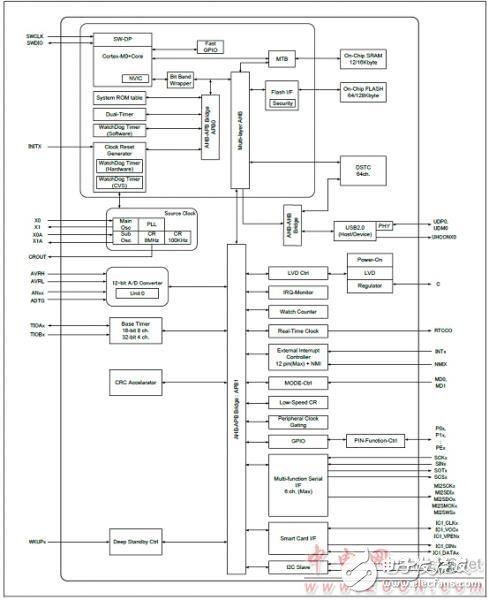
圖1.FM0-64L-S6E1C3功能框圖表
The FM0-64L-S6E1C3 MCU Starter Kit is a low cost development platform for Cypress’s FM0+ S6E1C-Series, a Flexible Microcontroller family with an ultra-low-power 32-bit ARM? Cortex?-M0+ CPU. This kit enables rapid development of embedded systems with onboard interfaces including USB, digital audio and an Arduino? Uno-compatible form-factor to prototype with Arduino shields.
圖2.FM0-64L-S6E1C3 MCU入門開發(fā)板外形圖
FM0-64L-S6E1C3 MCU入門開發(fā)板主要特性:
Featuring the FM0+ S6E1C-Series: ARM? Cortex-M0+ MCU
40MHz ARM? Cortex-M0+ MCU with 64-channel DMA
128KB flash, 16KB SRAM and 54 GPIOs
Industry’s most efficient 35μA/CoreMark? Score ?
Ultra-low-power consumption: Active - 40μA/MHz and Standby - 1.2μA
Advanced peripherals: USB host and device, HDMI-CEC and 6x Serial Interfaces
FM0-64L-S6E1C3 MCU入門開發(fā)板包括:
FM0+ S6E1C-Series Starter Board
USB Standard-A to Micro-B cable
Quick Start Guide
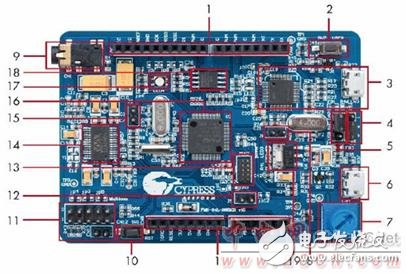
圖3.FM0-64L-S6E1C3 MCU入門開發(fā)板主要元件分布圖
1. Arduino Interface (CN7-CN10)
2. User button
3. MB9AF312K programmer and debugger (CMSIS-DAP)
4. Serial programming mode select (J3)
5. Power supply resource select (J4)
6. USB device connector (CN4)
7. Potentiometer
8. MB9AF312K programming mode jumper (J1)
9. Headphone and microphone jack (CN1)
10. Reset button
11. Multicon connector (CN12, CN13)
12. Jumper for current measurement (J5)
13. 10-pin JTAG connector
14. Stereo codec
15. Programming mode jumper (J2)
16. Cypress FM0+ MCU S6E1C32D0A
17. RGB LED
18. NOR flash
19. 3.3 V voltage regulator
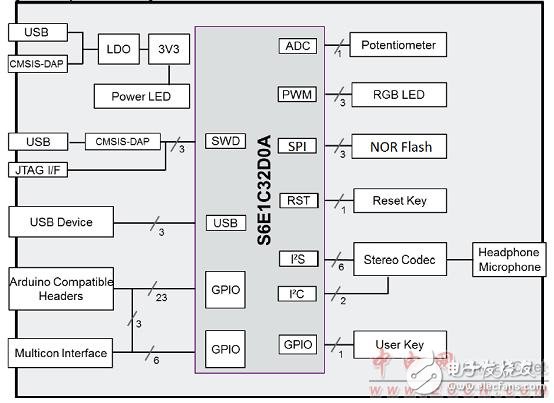
圖4.FM0-64L-S6E1C3 MCU入門開發(fā)板系統(tǒng)框圖
硬件主要特性:
? Cypress FM0+ S6E1C-Series MCU
? On-board ICE (CMSIS-DAP compatible)
? USB device interface
? Potentiometer
? NOR flash memory
? Stereo codec
? RGB LED
? User button
? Arduino compatible headers
? Multicon interface
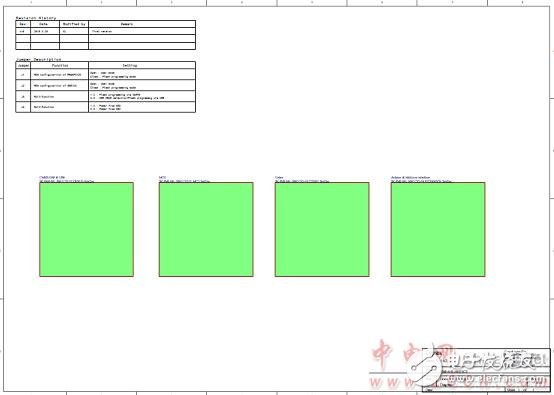
圖5.FM0-64L-S6E1C3 MCU入門開發(fā)板電路圖(1)
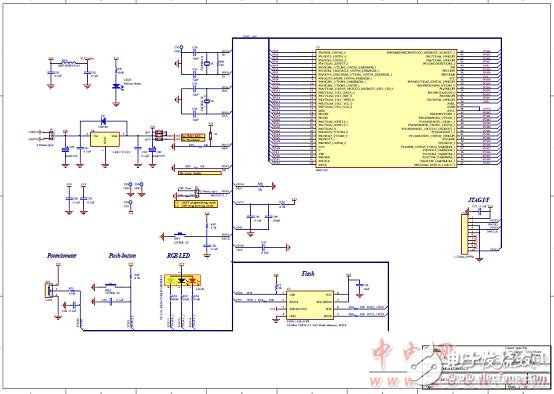
圖6.FM0-64L-S6E1C3 MCU入門開發(fā)板電路圖(2)
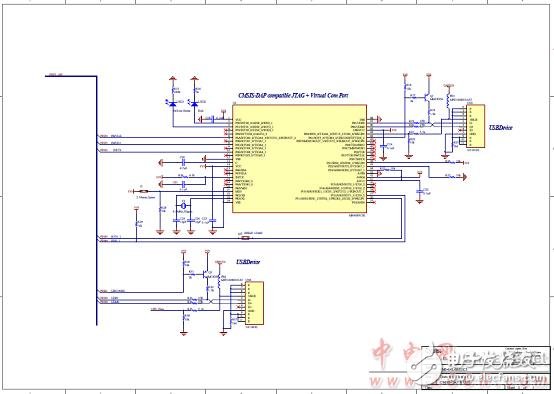
圖6.FM0-64L-S6E1C3 MCU入門開發(fā)板電路圖(2)
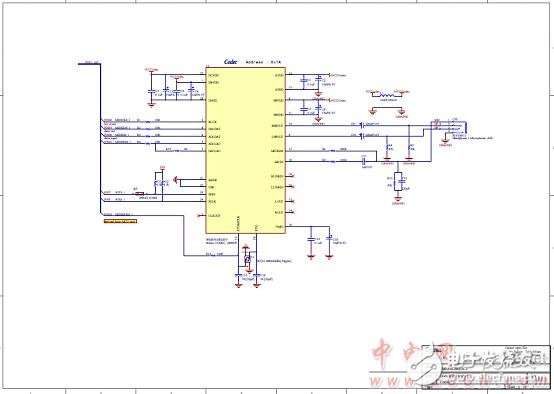
圖7.FM0-64L-S6E1C3 MCU入門開發(fā)板電路圖(3)
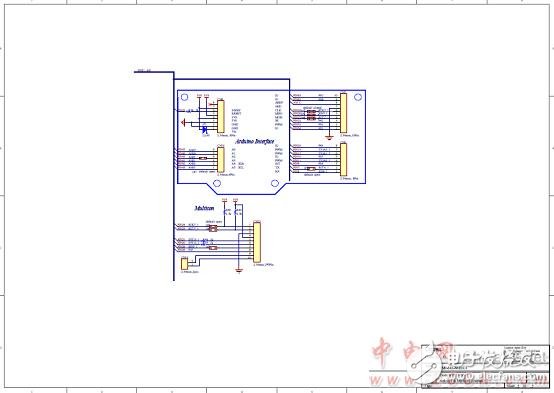
圖8.FM0-64L-S6E1C3 MCU入門開發(fā)板電路圖(4)
FM0-64L-S6E1C3 MCU入門開發(fā)板材料清單:
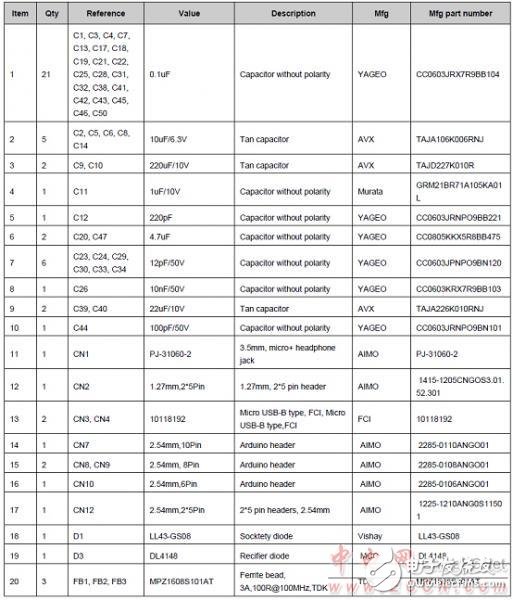
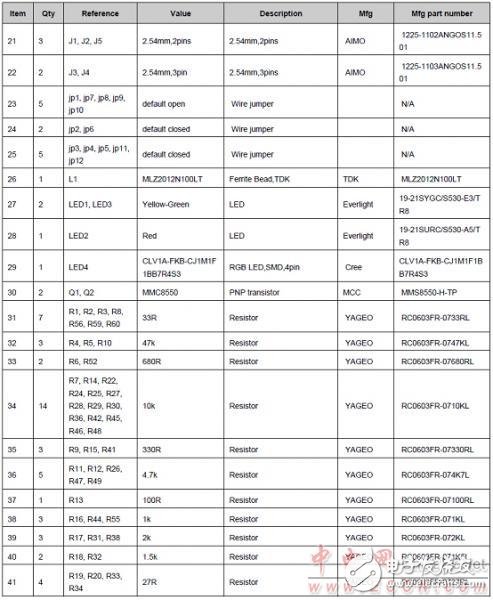
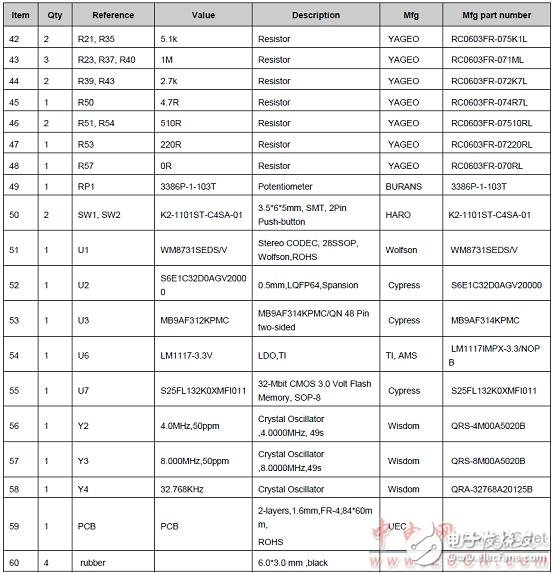
 電子發(fā)燒友App
電子發(fā)燒友App











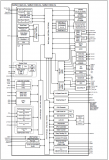
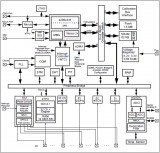
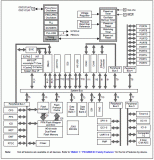












評(píng)論